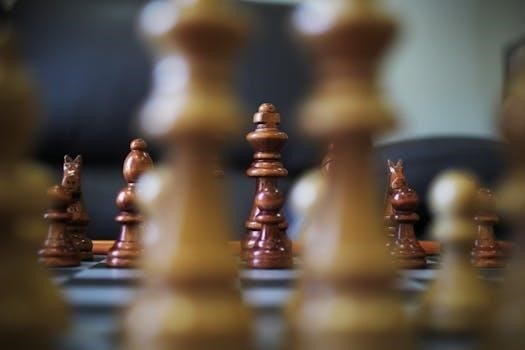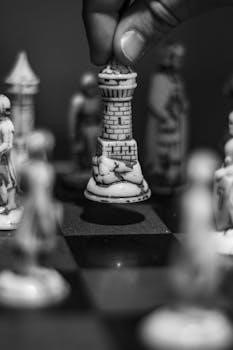
The Right Move⁚ A Comprehensive Guide to Chess Strategy and Tactics
This comprehensive guide delves into the crucial concept of “The Right Move” in chess. Employing cues, streamlining analysis, and using objective and subjective criteria are explored. It will cover tactical exercises, checkmating patterns, positional understanding, and strategic planning. This knowledge can be found in many chess books and learning materials.
The essence of chess lies not just in moving pieces, but in consistently making “the right move.” This concept transcends simple tactical calculations; it encompasses a deep understanding of positional nuances, strategic planning, and anticipation of an opponent’s intentions. Finding the right move requires a blend of pattern recognition, logical deduction, and sometimes, a touch of intuition. It’s about identifying the most advantageous option from a multitude of possibilities, considering both short-term gains and long-term consequences. This process involves analyzing potential threats, evaluating material imbalances, and recognizing opportunities for tactical strikes or positional improvements. The “right move” isn’t always the most obvious one; it often necessitates a deeper level of analysis and a willingness to explore less conventional options. Ultimately, mastering this ability to consistently identify the correct course of action is the hallmark of a skilled chess player. It is not only about winning, but also about improving decision-making skills by learning from our successes and our mistakes. This concept is what separates a novice from a master, and is essential for chess progress.
Understanding Chess Notation⁚ A Foundation for Analysis
Chess notation is the indispensable language that allows us to record, analyze, and share chess games. It provides a standardized method for describing each move, enabling players to revisit past games, learn from their mistakes, and study the strategies of masters. The most common system, algebraic notation, uses a combination of letters and numbers to identify each square on the chessboard. Files are designated by lowercase letters from ‘a’ to ‘h’, and ranks are numbered from 1 to 8. This allows every square to be uniquely identified. For example, the square in the bottom left corner for white is a1. Each move is then described by indicating the piece moved, along with the square it moved to. For instance, ‘Nf3’ indicates that a knight moved to the f3 square; Understanding this system is the key to accessing countless resources that will help you improve your skills, including books, articles and online databases. By learning chess notation you not only can analyze your own games, but also learn from great players.
Employing Cues to Identify Strong Chess Moves
Identifying strong chess moves isn’t about random guesses; it involves recognizing specific cues on the board. These cues can be both tactical and strategic in nature. Tactical cues include undefended pieces, loose pawns, and exposed kings. Recognizing these vulnerabilities allows a player to exploit them through direct attacks or combinations. Strategic cues often relate to pawn structure, space advantage, and piece activity. For example, a cramped position for your opponent may signify an opportunity to restrict their piece movement, while an open file might offer a promising avenue for your rooks. The presence of weaknesses in the opponent’s position is another important cue. By being alert to these clues, players can make informed decisions and move away from just moving pieces. Developing a keen eye for these cues is a fundamental step in becoming a skilled chess player. Also, it is very important to constantly analyze the position of your pieces and how they work together.

Streamlining Analysis of Move Consequences
Streamlining the analysis of move consequences is vital for efficient chess play. Instead of calculating every possible variation, focus on the most relevant sequences. This involves assessing the potential impact of a move on your position, your opponent’s position, and the overall balance of the game. Begin by identifying candidate moves based on the cues you’ve recognized. Then, evaluate the immediate consequences of each of these candidate moves including checks, captures, and threats. Look beyond the immediate move and consider the potential for follow-up moves. It is important to be aware of the basic principles of chess. A major part of move analysis is anticipating your opponent’s response and how that might impact your plan. Visualize the resulting position and assess its strengths and weaknesses for both sides. By streamlining your analysis process, you’ll make more informed decisions and avoid wasting time on irrelevant variations. This skill is essential for playing chess quickly and effectively. Practice will improve your ability.
Objective and Subjective Criteria for Choosing the Right Move
Selecting the right move in chess involves a blend of objective and subjective criteria. Objective criteria include material balance, such as the number of pieces each player has, and tactical considerations, like checks, captures, and threats. Objectively assessing the position involves identifying weaknesses in your opponent’s camp and strengths in your own. Subjective criteria, on the other hand, are more nuanced. This includes evaluating the positional aspects, like piece activity, pawn structure, and king safety. These are not always quantifiable, and an experienced player’s intuition often plays a role. You must analyze the strategic importance of moves. Consider the long term implications. Furthermore, assess the psychological aspect of the game, trying to understand your opponent’s intentions. A move that might seem objectively equal could be subjectively better if it leads to a position you understand better. A move might be more useful in the current stage of the game. Combining objective facts with subjective judgement is important.


The Right Move⁚ Tactical Exercises and Checkmating Patterns
Mastering “The Right Move” in chess heavily relies on tactical proficiency and pattern recognition, particularly in checkmating situations. Tactical exercises are essential, helping players identify combinations and calculate forcing sequences. These exercises often involve sacrifices, pins, skewers, and forks, aimed at gaining a decisive advantage. Recognizing common checkmating patterns, such as back-rank mates, smothered mates, and queen sacrifices, enables quick and efficient finishes. Training involves solving puzzles with varying levels of difficulty, from simple checkmates in one move to more complex combinations spanning several moves. Regular practice improves the ability to spot these patterns within a game, helping players seize tactical opportunities and deliver checkmate. Familiarity with common tactical motifs allows players to identify the right moves to convert a material or positional advantage to a win. These exercises build confidence and improve calculation skills which are crucial for success in chess.
Tactical Exercises for Checkmate in 1-4 Moves
Developing the ability to identify checkmates within 1 to 4 moves is a cornerstone of chess tactical training. These exercises hone the player’s ability to calculate ahead and spot forcing sequences. Starting with simple checkmates in one move helps beginners grasp basic patterns involving direct attacks on the king. As the complexity increases, exercises involving checkmates in two, three, and four moves introduce more intricate combinations. These puzzles often incorporate tactical themes like pins, skewers, forks, and discovered attacks. Regular practice with these types of exercises not only develops calculation skills but also enhances pattern recognition, allowing players to quickly evaluate positions. The aim is to train the mind to see beyond immediate threats and grasp the underlying tactical possibilities that lead to a checkmate. Such training is crucial for improving a player’s tactical vision and overall chess skill, allowing them to find the right moves when they matter most.

Positional Understanding and Strategic Planning
Moving beyond immediate tactics, positional understanding and strategic planning form the bedrock of strong chess play. Positional understanding involves assessing the long-term implications of a position, considering factors like pawn structure, piece activity, and king safety. Strategic planning, in turn, involves formulating long-range goals and devising a plan to achieve them. This requires a deep understanding of positional elements and the ability to anticipate the opponent’s intentions. A good strategic plan often focuses on improving piece activity, controlling key squares, and exploiting weaknesses in the opponent’s position. It is not just about making individual moves, but about orchestrating a sequence of moves that gradually gain an advantage. Strategic thinking often requires patience and the willingness to take a long-term view. Players must be able to evaluate the balance of the position and identify the key elements that are likely to decide the game’s outcome. By developing positional understanding, players can create opportunities for tactical strikes and make their plans more effective.
The Importance of Understanding Opponent’s Intentions
A critical aspect of choosing the right move in chess lies in understanding your opponent’s intentions. Chess is not just about your own plan; it’s also about anticipating and reacting to your opponent’s. This involves analyzing their moves, trying to discern their underlying strategy, and recognizing their potential threats. This ability goes beyond calculating immediate tactical sequences; it involves a deeper understanding of your opponent’s positional preferences and typical plans. By understanding their intentions, you can proactively defend against their threats, disrupt their plans, and create opportunities for your own attacks. A key aspect is identifying the motifs that they typically use in their game, and how they might be trying to set up combinations. This requires a combination of observation, analysis, and pattern recognition. You also need to be aware of the psychological aspects of the game, recognizing that your opponent may try to mislead or bluff. By understanding their intention, you can make more informed decisions, which is often the difference between winning and losing.
Resources for Improving Chess Skills
Numerous resources exist to aid in improving your chess skills, all of which are designed to help you find the ‘right move’ more consistently. These resources cater to various learning styles and skill levels. Firstly, there are a multitude of online platforms that offer interactive lessons, tactical puzzles, and the opportunity to play against others. These platforms often provide analysis tools to evaluate your games and pinpoint areas for improvement. Secondly, many chess books delve into specific aspects of the game, such as openings, middlegames, and endgames, providing detailed explanations and examples. These resources are essential for building a solid theoretical foundation. Additionally, chess magazines, both print and digital, often include annotated games and insightful articles that help you understand master-level strategies. Lastly, consider joining a local chess club where you can play against opponents of varying skill levels, learn from their experiences, and gain valuable insights. Furthermore, some organisations offer free chess tournaments, which are an invaluable way to gain experience and to assess your progress.
Books and Materials for Learning Chess
The journey to mastering chess and finding ‘the right move’ is greatly enhanced by a wealth of available books and materials. For beginners, “Learn Chess the Right Way” by Susan Polgar is an excellent series that uses puzzles to teach fundamental concepts. Books like “Logical Chess⁚ Move by Move” by Irving Chernev offer a historical perspective while demonstrating the reasoning behind each move; More advanced players can benefit from “Your Best Move” which offers a conceptual framework for finding the strongest move, or “How Life Imitates Chess” by Garry Kasparov which explores strategic thinking. Additionally, many chess publishers, such as New In Chess, provide a plethora of resources, including magazines and yearbooks, often filled with annotated games from top players. Furthermore, resources often include chess workbooks that feature notation scoresheets, enabling you to record your games and to analyse them later. These books and materials cover varied aspects of chess, from tactics to positional understanding, all designed to improve your game. ChessBase Magazine also offers downloadable materials and puzzles that can be used for practice.
The Right Move Chess Foundation and Community Impact
The Right Move Chess Foundation plays a vital role in fostering chess education and community engagement. This foundation, often in partnership with organizations like the New York State Department of Parks, provides free scholastic chess tournaments for youth, particularly in the New York City area. Their work extends to offering free chess competition, serving the greater metropolitan area, and providing opportunities for players of all levels, including open, under 1400, under 700, and unrated beginner sections. The foundation’s commitment is seen through years of dedicated service, and the impact on the community is significant, fostering strategic thinking and problem-solving skills. The Right Move also acknowledges contributions of individuals who have dedicated themselves to chess and scholastic activities, underscoring the importance of these programs. These community-focused efforts are making a real difference in the lives of young players, and encouraging more to learn and love the game. Their ongoing efforts ensure that chess is accessible to all.